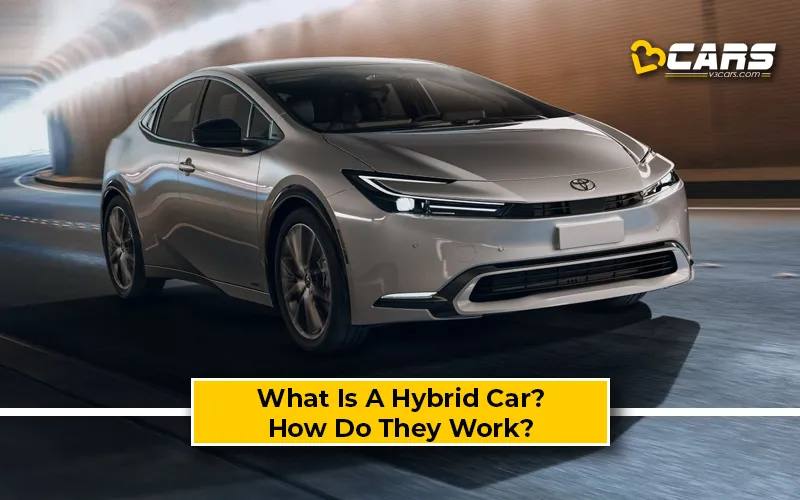What Is A Hybrid Car And How Does It Work? A Comprehensive Guide
In an era of growing environmental awareness and escalating fuel costs, hybrid cars have emerged as a compelling solution to address both concerns. These vehicles offer the promise of increased fuel efficiency and reduced emissions, but how do they actually work? In this comprehensive guide, we'll delve into the inner workings of hybrid cars, demystifying their technology, benefits, and the different types available in the market.

What Is A Hybrid Car?
At its core, a hybrid car combines 2 distinct power sources: an internal combustion engine (usually petrol-powered) and an electric motor. The integration of these power sources aims to optimise fuel efficiency while minimising harmful emissions. The key to the success of hybrid technology lies in its ability to switch between these power sources or operate them simultaneously, depending on driving conditions and energy demands.
How Do Hybrid Cars Work – The Basics
Now, let's explore the fundamental principles that make hybrid cars function efficiently:
1. Regenerative Braking: One of the key features of hybrid vehicles is regenerative braking. When you apply the brakes or coast, the electric motor operates as a generator, converting kinetic energy into electrical energy. This energy is then stored in the hybrid battery for later use.
2. Electric Mode: Hybrids can operate in electric-only mode, especially at low speeds or when cruising with minimal power demands. The electric motor draws energy from the battery pack, allowing the vehicle to run silently and emission-free for short distances.
3. Power Blending: Hybrids use a power control unit (PCU) or hybrid control computer to manage the flow of power between the internal combustion engine and the electric motor. The PCU ensures that power is supplied seamlessly, optimising performance and efficiency.
4. Engine Start/Stop: To conserve fuel, hybrid cars often feature an engine start/stop system. When the vehicle comes to a stop, the internal combustion engine shuts off, and the electric motor takes over. The engine restarts automatically when more power is needed.
5. Energy Management: The hybrid system continually monitors various factors, including battery state of charge, driving conditions, and driver input. Based on this data, it decides when to use electric power, when to rely on the internal combustion engine, or when to combine both for maximum performance.
Hybrid cars are a fascinating combination of traditional internal combustion engines, like petrol or diesel, and electric motors. These two power sources work together in harmony to propel the vehicle, offering several key advantages over conventional ICE-powered cars.
Also Read: How To Make Tyres Last Longer
Note: If You Want to Buy a New Car, Calculate Car Loan EMI with V3Cars
What Are The Pros Or Advantages Of Hybrid Cars?
- Environmental Friendliness: Hybrid vehicles are known for their reduced dependence on fossil fuels, resulting in lower CO2 emissions. This makes them a greener choice, contributing to a cleaner environment.
- Regenerative Braking: Hybrid cars feature a regenerative braking system that captures energy during braking and uses it to recharge the battery. This innovative system minimises the need for frequent recharging.
- Higher Resale Value: As hybrids grow in popularity, their resale value tends to be higher than the average, making them a wise investment.
What Are The Cons Or Disadvantages Of Hybrid Cars?
- Higher Costs: Hybrid vehicles can be more expensive than their traditional petrol or diesel counterparts, and their technology may require more expensive maintenance.
- Less Power: Hybrid systems often provide less power compared to traditional petrol-powered engines, affecting their acceleration and top speed.
- High Voltage Batteries: In case of accidents, the high-voltage batteries in hybrid cars pose a risk of electrocution, making rescue operations more challenging.
What Are The Different Types Of Hybrid Cars?
- Parallel Hybrids: These are the most common type of hybrid, where an electric motor and a petrol engine are connected in a common transmission, blending the 2 power sources. The vehicle can run on the internal combustion engine, electric motor, or a combination of both.
- Series Hybrids: In this design, the internal combustion engine (ICE) is not connected to the wheels but is used solely to produce electricity for a generator that recharges the battery. The electric motor provides all the propulsion.
- Plug-in Hybrids: These hybrids have larger batteries that can be charged externally. They can operate on electric power alone for a typical daily commute. Once the electric range is depleted, the car functions as a conventional parallel hybrid.
- Mild Hybrids: In mild hybrids, the electric motor cannot move the car independently. Instead, a petrol or diesel engine does most of the work, with the electric motor providing assistance to enhance fuel efficiency and performance. Examples of mild hybrid cars in India include Maruti Suzuki Brezza, Maruti Nexa XL6, etc.
What Are The Key Components Of A Hybrid Car?
- Battery (auxiliary): Provides electricity for starting the car and powering accessories.
- DC/DC Converter: Converts high-voltage DC power from the traction battery to lower-voltage DC power for accessories and recharging the auxiliary battery.
- Electric Generator: Generates electricity during braking to recharge the battery.
- Electric Traction Motor: Propels the vehicle using power from the traction battery.
- Exhaust System: Channels exhaust gases out of the tailpipe, equipped with a catalyst to reduce emissions.
- Fuel Filler and Tank: Stores fuel on board for the engine.
- Internal Combustion Engine (Spark-Ignited): Combines fuel with air and ignites it with a spark plug.
- Power Electronics Controller: Manages the flow of electrical energy between the battery and the motor, controlling speed and torque.
- Thermal System (Cooling): Maintains proper operating temperatures for various components.
- Traction Battery Pack: Stores electricity for the electric motor.
- Transmission: Transfers mechanical power from the engine or electric motor to drive the wheels.
Hybrid cars represent a remarkable blend of conventional and electric power sources, offering drivers improved fuel efficiency, reduced emissions, and a smoother driving experience. Understanding the fundamentals of how hybrid technology works empowers consumers to make informed choices about the vehicles they drive. As automakers continue to innovate and develop hybrid systems, the future looks promising for these eco-friendly and economically savvy automobiles. Whether you're interested in a parallel, series, plug-in, or mild hybrid, the world of hybrid cars offers a range of options to suit your driving needs and environmental goals.
Also Read: How To Negotiate With Car Dealers And Get The Best Discount
Note: Calculate Car Fuel Cost with V3Cars for India and Other Countries


0 Comments